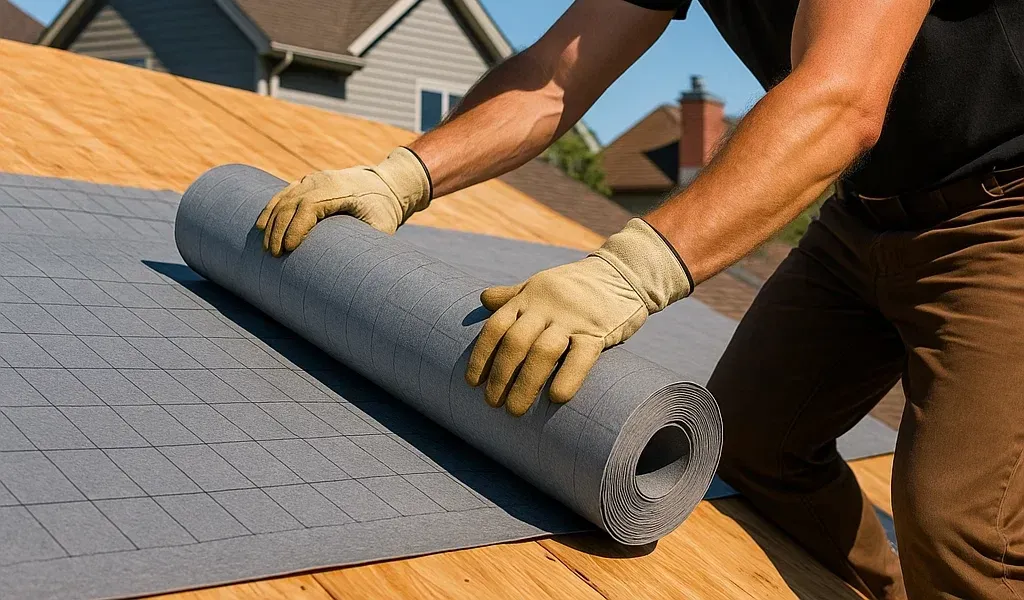
The Smart Way to Keep Your Roof Leak-Free
A great roof starts with what you can’t see. Roof underlayment is that hidden layer that quietly does the heavy lifting—keeping water out, adding years to your roof, and saving you headaches down the road.
Let’s break it down.
Introduction to Roof Underlayment
Roof underlayment is a sheet that goes between your roof deck and your shingles or tiles. It acts like a safety net for your home. If wind or rain ever gets past your roof’s outer layer, underlayment is your backup plan.
Types of Roof Underlayment
Here’s what you need to know. There are three main types:
Asphalt-Saturated Felt
Old-school but still reliable. Felt is made with a base material—usually organic or fiberglass—soaked in asphalt. It’s affordable and it gets the job done for most basic roofs.Synthetic Underlayment
This is the new standard for most homes. Synthetic is lighter, tougher, and stands up better to water. It’s easy to handle, resists tearing, and gives you extra peace of mind if you live somewhere with heavy weather.Rubberized Asphalt
The premium pick. It sticks to your roof deck and seals tight around nails. If you get a lot of ice, snow, or want the best possible water protection, this is it.

Benefits of Using Roof Underlayment
What this really means is underlayment matters for a lot of reasons:
Stops leaks before they start
Shields your house from wind-driven rain and snow
Helps your shingles last longer by keeping moisture away
May improve your roof’s fire resistance (check the specs)
Keeps you covered for code and insurance requirements
Handles debris and storms when your top layer can’t
How to Choose the Right Roof Underlayment
Not all roofs or climates are the same, so pick smart:
Roof Slope: If your roof is low-sloped, go for something with top-notch waterproofing.
Climate: Rain, ice, or wild storms? Synthetic or rubberized is the way to go.
Roof Material: Some shingles or tiles need specific underlayment for warranties.
Budget: Felt is budget-friendly. Synthetic and rubberized cost more but last longer.
DIY Friendly: If you’re installing it yourself, synthetic is easier to work with.
Installation Tips
Here’s the thing: even the best underlayment won’t work if you don’t install it right.
Make sure the roof deck is clean and dry before you start
Lay underlayment from the eaves up, always overlapping each row
Use the right nails, staples, or go with self-adhesive when required
Double-check valleys, corners, chimneys, and any place water can sneak in
Always follow the manufacturer’s instructions and local building codes
Common Mistakes to Avoid
Let’s be real—these are the mistakes that cost homeowners money:
Not overlapping the sheets enough
Putting underlayment on a damp or dirty roof
Picking the wrong type for your climate or roof design
Rushing the job when the weather’s bad
FAQs
Do I really need roof underlayment?
Yes, if you want a roof that actually protects your house from leaks and weather. Most building codes require it.
How long does it last?
Synthetic underlayment can last 25 to 40 years. Felt gives you 10 to 20 years. It all depends on what you pick and how you install it.
Can I do this myself?
If you’re handy and the roof isn’t too steep, you can install felt or synthetic underlayment. For anything tricky, or if you want it perfect, hire a pro.
Conclusion
The truth is, roof underlayment isn’t glamorous, but it’s essential. Get it right and you’ll avoid leaks, save on repairs, and your roof will thank you for years. Need help or want pro advice? Reach out to Best Construction Products. We keep it simple, smart, and solid.
If you have questions or need a quote, visit us here or email us at [email protected]—real answers, no hassle.